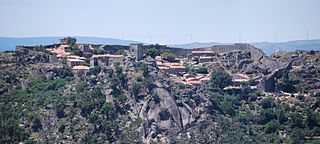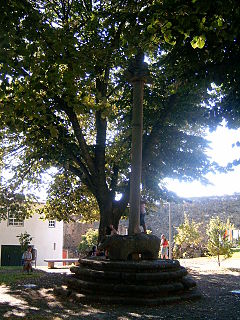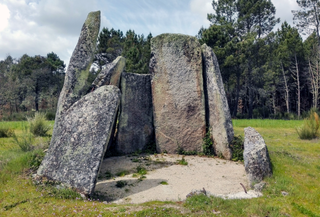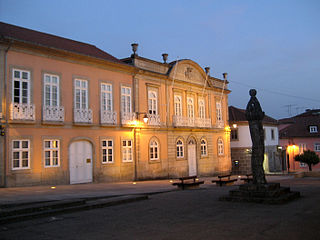
The small Chapel of Sao Pedro de Balsemao, is situated in the civil parish of Sé, municipality of Lamego in the northern region of Portugal. It was a Visigothic sanctuary dating back to the 7th century, although it has Baroque elements, in particular, in the South Gate and the western facade, which adjoins a later residential building.

Alandroal is a municipality in the Portuguese district of Évora located on the eastern frontier with Spain along the right margin of the Guadiana River in the Central Alentejo region. It is located 341 metres (1,119 ft) above sea level, northeast of Évora and southeast of Estremoz. The population in 2011 was 5,843, in an area of 542.68 km².

Nelas is a municipality located in the Centro Region of continental Portugal. The population in 2011 was 14,037, in an area of 125.71 km².

The Casa dos Bicos is a historical house in the civil parish of Santa Maria Maior, in the Portuguese municipality of Lisbon. The house, built in the early 16th century in the Alfama neighbourhood, has a curious façade of spikes, influenced by Italian Renaissance palaces and Portuguese Manueline styles. It survived the disastrous 1755 Lisbon earthquake that destroyed much of the city, but over time was abandoned as a residence and used as a warehouse. After a 20th-century renovation, it became the headquarters of the José Saramago Foundation and a location of the Museum of Lisbon.

The Castle of Moreira de Rei is a well-preserved medieval castle located in the civil parish of Moreira de Rei, in the municipality of Trancoso, Portuguese district of Guarda.

The Castle of Sortelha (Portuguese: Castelo de Sortelha is a castle in the civil parish of Sortelha in the municipality of Sabugal in the Portuguese Centro region, classified as a National Monument.

The Castle of Alcanede, is a Portuguese medieval castle in civil parish of Alcanede, in the municipality of Santarém, in the Ribatejo district of Santarém.

The Castle of Folgosinho, is a medieval castle in the civil parish of Folgosinho, municipality of the Gouveia in the district of Guarda in the Centre region of Portugal.

The Pillory of Bragança is a 15th-century sculpted stone column with symbolic political, administrative and judicial significance, erected over a four-step octagonal platform, located in the civil parish of Sé, Santa Maria e Meixedo, municipality of Bragança. It consists of a cylindrical column erected over a square platform, sculpted with zoomorphic symbols, anthropomorphic scenes and the shield of the city of Bragança. Its structural design and sculptural ornamentation is characteristics of the era; the column is classified as a National Monument since 1910.

Dolmen of Carapito I is a megalithic monument located in the civil parish of Carapito, in the municipality of Aguiar da Beira in the Guarda District of Portugal.

Aguiar da Beira is a former freguesia in Aguiar da Beira Municipality, Guarda District, Portugal. It was merged with Coruche in 2013 to form the new freguesia Aguiar da Beira e Coruche. The Pillory of Aguiar da Beira is located in this former freguesia.

The Pillory of Arcos de Valdevez is a 15th-century sculpted stone column with symbolic political, administrative and judicial significance, located in the civil parish of Arcos de Valdevez (Salvador), Vila Fonche e Parada, municipality of Arcos de Valdevez.

The Quinta dos Lagares d'El-Rei, is a quinta and manor house on the Portuguese estate of Quinta dos Lagares d'El-Rei, part of the Senhorio dos Lagares d'El-Rei, a feudal fiefdom, seated in the civil parish of Alvalade, in the municipality of Lisbon.

The Pillory of Braga is a 15th-century sculpted stone column with symbolic political, administrative and judicial significance, located in the civil parish of Maximinos, Sé e Cividade, municipality of Braga.
The Castle of Seda is a medieval castle located in the civil parish of Seda, in the municipality of Alter do Chão, in the Portuguese district of Portalegre.

The Castle of Pena de Aguiar is a medieval castle, alternately the Castle of Aguiar da Pena, situated in the civil parish of Telões, in the municipality of Vila Pouca de Aguiar, in the Portuguese district of Vila Real.

The Castle of Castelo Melhor is a medieval castle located in the civil parish of Castelo Melhor, in the municipality of Vila Nova de Foz Côa, Portuguese Guarda. The castle is one of the best examples of secondary medieval fortresses, erected in one of the more peripheral zones of the peninsular kingdoms.

The Castle of Aguiar da Beira, is a Portuguese medieval castle in civil parish of Aguiar da Beira e Coruche, in the municipality of Aguiar da Beira, in the Centro district of Guarda.

The Pillory of Lisbon is a pillory situated in the municipal square of the Portuguese capital, classified as a National Monument.



















